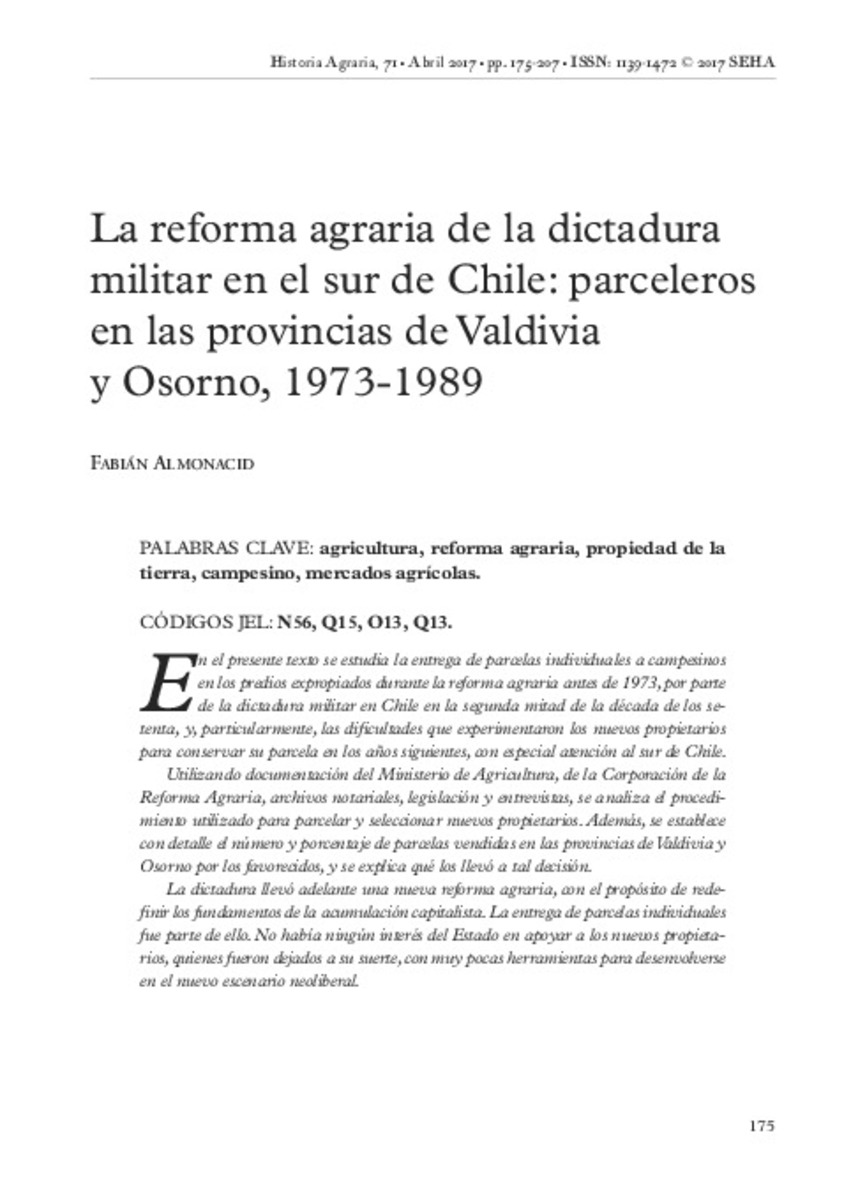Mostrar el registro sencillo del ítem
La reforma agraria de la dictadura militar en el sur de Chile: parceleros en las provincias de Valdivia y Osorno, 1973-1989
| dc.contributor.author | Almonacid-Zapata, Fabián | |
| dc.date.accessioned | 2017-03-13T09:15:54Z | |
| dc.date.available | 2017-03-13T09:15:54Z | |
| dc.date.issued | 2017-04 | |
| dc.identifier.issn | 1139-1472 | |
| dc.identifier.uri | http://hdl.handle.net/10234/166653 | |
| dc.description.abstract | This article examines the process of distribution of individual parcels of land to peasants labouring on large expropriated estates in the period of the agrarian reform before 1973. This land distribution took place in the second half of the seventies, under the regime of the military dictatorship. The challenge faced by the new small-scale landowners in seeking to keep their parcels of land is discussed, with special focus on what happened in southern Chile. Based on documents obtained from the Ministry of Agriculture, the Agricultural Reform Corporation (CORA), notary public archives, interviews and laws, this study also examines the procedure used to divide the land into parcels, and how the selection of beneficiaries was carried out. The number and percentage of plots sold by the beneficiaries in the provinces of Valdivia and Osorno and their motivation to sell are outlined in detail. The new agrarian reform implemented by the military dictatorship had the purpose of redefining the foundations of capitalist accumulation, and the distribution of individual plots of land is an example of this. The new small-scale landowners had few tools to cope with the new neo-liberal scenario; yet they were left to fend for themselves as the state had no interest in supporting them. | ca_CA |
| dc.description.abstract | En el presente texto se estudia la entrega de parcelas individuales a campesinos en los predios expropiados durante la reforma agraria antes de 1973, por parte de la dictadura militar en Chile en la segunda mitad de la década de los setenta, y, particularmente, las dificultades que experimentaron los nuevos propietarios para conservar su parcela en los años siguientes, con especial atención al sur de Chile. Utilizando documentación del Ministerio de Agricultura, de la Corporación de la Reforma Agraria, archivos notariales, legislación y entrevistas, se analiza el procedimiento utilizado para parcelar y seleccionar nuevos propietarios. Además, se establece con detalle el número y porcentaje de parcelas vendidas en las provincias de Valdivia y Osorno por los favorecidos, y se explica qué los llevó a tal decisión. La dictadura llevó adelante una nueva reforma agraria, con el propósito de redefinir los fundamentos de la acumulación capitalista. La entrega de parcelas individuales fue parte de ello. No había ningún interés del Estado en apoyar a los nuevos propietarios, quienes fueron dejados a su suerte, con muy pocas herramientas para desenvolverse en el nuevo escenario neoliberal. | ca_CA |
| dc.format.extent | 33 p. | ca_CA |
| dc.format.mimetype | application/pdf | ca_CA |
| dc.language.iso | spa | ca_CA |
| dc.publisher | Sociedad Española de Historia Agraria (SEHA) | ca_CA |
| dc.relation.isPartOf | Historia agraria: Revista de agricultura e historia rural, nº 71, 175-207 | ca_CA |
| dc.rights | © 2017 SEHA | ca_CA |
| dc.rights.uri | http://rightsstatements.org/vocab/InC/1.0/ | * |
| dc.subject | Agrarian reform | ca_CA |
| dc.subject | Land ownership | ca_CA |
| dc.subject | Peasants | ca_CA |
| dc.subject | Agricultural markets | ca_CA |
| dc.subject | Campesinos | ca_CA |
| dc.subject | Reforma agraria | ca_CA |
| dc.subject | Mercados agrarios | ca_CA |
| dc.subject | Propiedad de la tierra | ca_CA |
| dc.title | La reforma agraria de la dictadura militar en el sur de Chile: parceleros en las provincias de Valdivia y Osorno, 1973-1989 | ca_CA |
| dc.type | info:eu-repo/semantics/article | ca_CA |
| dc.subject.jel | N53 | ca_CA |
| dc.subject.jel | Q15 | ca_CA |
| dc.subject.jel | O13 | ca_CA |
| dc.subject.jel | Q13 | ca_CA |
| dc.rights.accessRights | info:eu-repo/semantics/openAccess | ca_CA |
| dc.relation.publisherVersion | http://www.historiaagraria.com/numero.php?n=71 | ca_CA |







